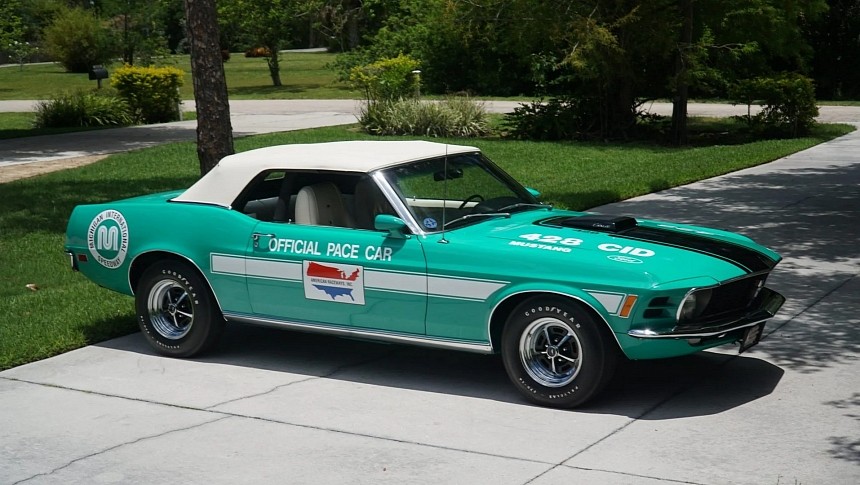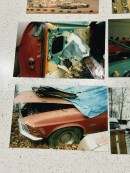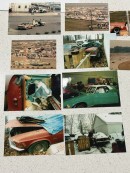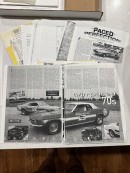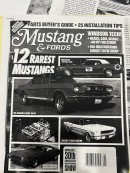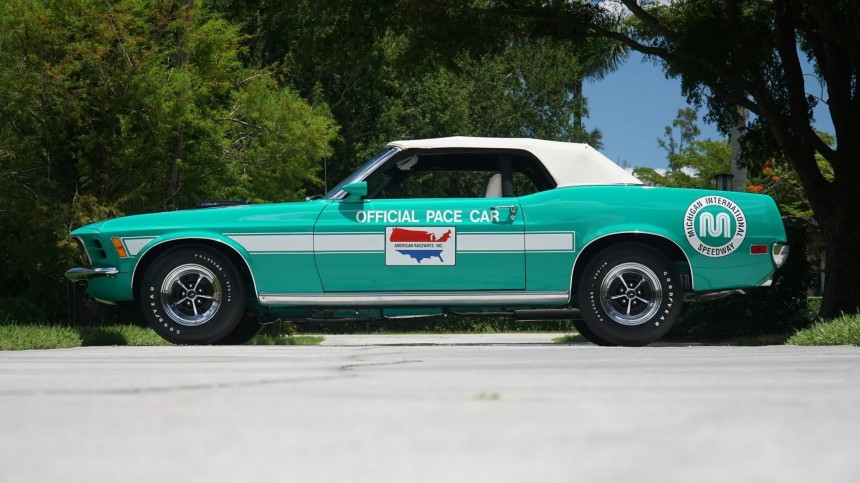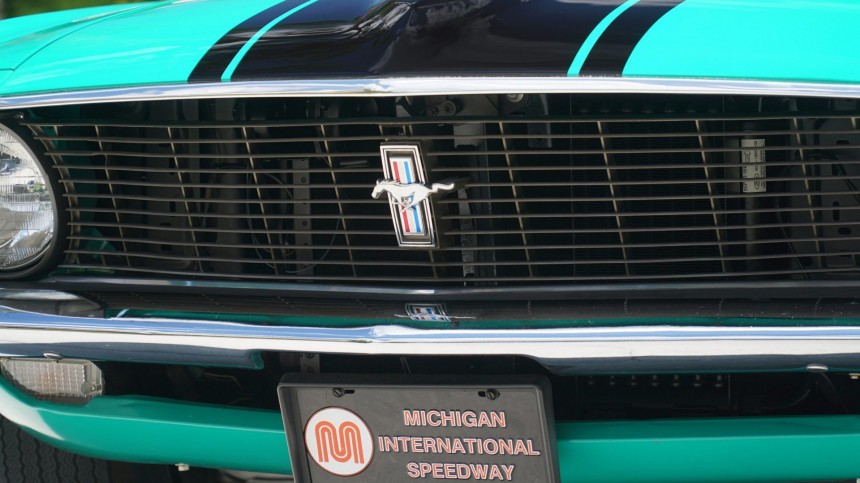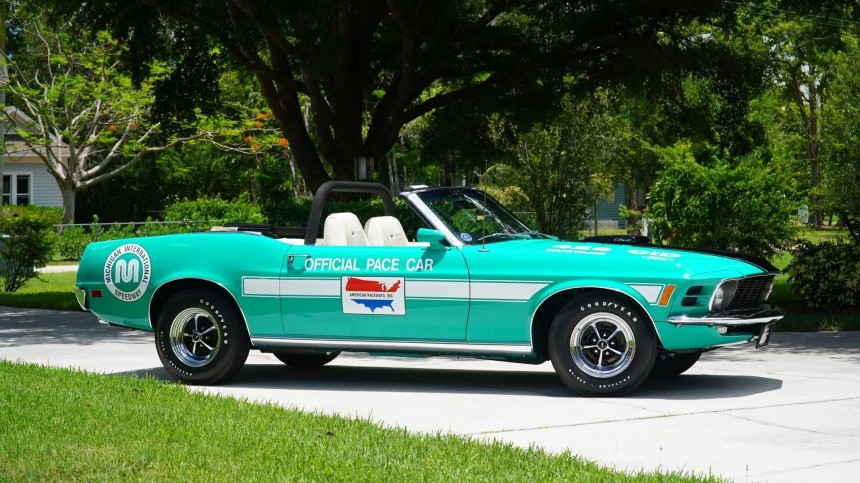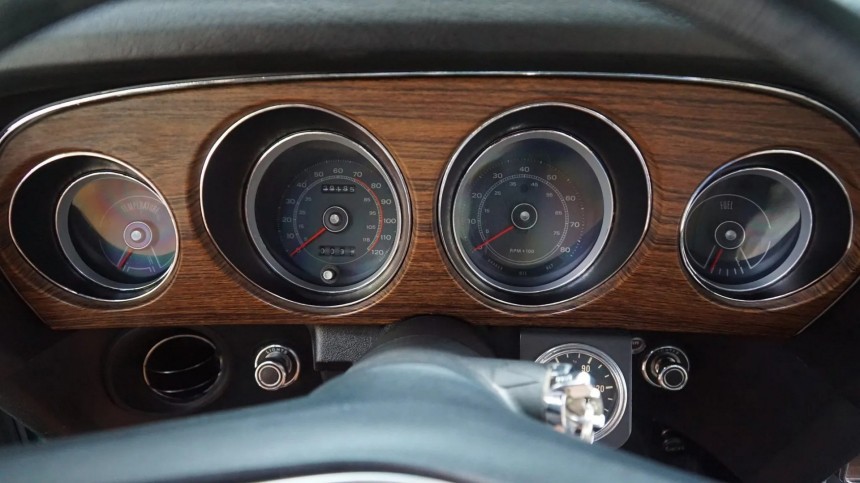Bob Tasca is generally credited with the sales dictum “Win on Sunday, sell on Monday.” Still, there’s a catch to this catchphrase of profit-making automotive entrepreneurship. To win, one must first race; to do that, a racecourse is mandatory. That spurred a Detroit investor’s interest in putting his money in the high-speed-oval business in the late sixties. That is also how this magnificently rare convertible Cobra Jet Mustang – vintage 1970 – was born.
Larry LoPatin was a successful lawyer from 1960s Motor City who saw the motorsport’s immense potential for generating cash floods over the weekend. One thing led to another, and in 1968, the entrepreneur was gazing upon the Michigan International Speedway. That was his newly-built race track that would lure in millions of former U.S. president’s portraits (legally tendered by the Federal Reserve).
One month before the moon landing, the first NASCAR event confirmed the theory (see the second video for a period report of the race). LoPatin expanded his raceway portfolio with three more tracks in Texas, Atlanta, and California. He established a company to manage the ovals: American Raceways International (ARI). So shiny was the perspective of the racing tracks business that ARI shook hands with Ford Motor Company for a limited production of pace cars.
Each of the five managed by ARI courses was to receive its own 1970 Ford Mustang 428 Cobra Jet convertible. And yes, there were five cars for five tracks, although the fifth circuit – planned to be built in New Jersey- - never made it past the land acquisition phase. However, Ford held its part of the deal and built the cars at the end of 1969.
The car featured in this story was the pace car at the Michigan International Speedway – the first oval In ARI’s collection – but, for some reason, its color was changed to orange. Play the second video at the 3:50 mark to see it in action. The story is that ARI considered the bright Grabber Orange hue a better color choice and had the cars repainted.
However, at the unveiling ceremony held at the Tavern-on-the-Green in Central Park, New York, in early 1970, each car appeared in its original color, and the guests were invited to guess the pace color. To everyone’s surprise, supermodels started peeling the wrapping, unveiling the orange underneath the plastic film.
The five ARI Mustangs were identical – specification-wise – and each had its own livery, per factory records (Pastel Blue, Calypso Coral, Grabber Blue, Competition Yellow, and Grabber Green). The Grabber Green one is the hero of this article and has a story to tell. Since it had to lead the 200-mph (322 kph) pack, the ARI Mustang needed high-performance parts to keep up with the roaring hot-action racers.
Interestingly, the five cars weren’t solely built by Ford; instead, the custom work was done by an outside job shop in Detroit before the Mustangs were delivered to American Raceways International.
The 428 cubic-inch (7.0-liter) Cobra Jet V8 powerplant was taken out and delivered to Ford Engineering, where it was blueprinted and balanced. The valves got a three-angle upgrade, with their springs shimmed, and the connecting rods got shot-peening hardening. Also, the standard Cobra Jet gaskets and pistons were swapped with heavy-duty parts for impeccable on-track performance.
Naturally, the standard C6 Select-Shift automatic three-speed gearbox received the fine-tuning treatment (just like the big-block it was mated to, the transmission was blueprinted and balanced). The rear end got the high-speed 3.00:1 gearing, more appropriate to push the Mustang past 140 mph (225 kph) than other high-performance diffs with numerically higher ratios.
The body was lowered one inch / 25.4 mm – Ford had one wind of the front coils torched. High-performance staggered shocks stiffened the ride and made the ARI pace cars more stable when going on the banks at more than 120 mph (200 kph).
The custom speed shop installed an oil radiator to keep the engine lubricant within the optimal temperature parameters and a 150-psi Stewart-Warner all-pressure gauge to the right of the steering column. A baffled NASCAR T-pan replaced the standard Cobra Jet oil pan, so the 428 V8 would not rub metal on metal on the ovals.
Apart from the 1.5-inch (38 mm) padded roll bar, the convertible boasts 16 comfort and cosmetics options, like air conditioning, a center console, a push-button Philco AM radio, faux woodgrain inserts, lap belts, and white vinyl upholstery.
Yet, despite all efforts and funding, American Raceways International didn’t have a long and prosperous endeavor in racing, and Ford sold the Mustangs. The Grabber Green example you can admire in the gallery ended in the hands of a private owner and spent almost 39,000 miles on the roads (while also receiving a red coat). It was then parked outside – under a tarp (see the photo from the period) – before being discovered in 1984 by an interested collector, Gary Pietraniec.
It would be another seven years before this one-in-five Ford Mustang and Mr. Pietraniec would get together, and the much-need restoration began. The floor pans were replaced after nearly two dozen Michigan winters had sunk their teeth in the metal.
This car was sold last year for the almost bargain price of $192,500 – considering its rarity, the value isn’t as high as some might expect. In 1970, only 47 Cobra Jet ‘verts were assembled, and five of them got the race pacing honors. The car is now for sale again and has already reached the $100,000 bid mark, with nine days left of the auction.
One month before the moon landing, the first NASCAR event confirmed the theory (see the second video for a period report of the race). LoPatin expanded his raceway portfolio with three more tracks in Texas, Atlanta, and California. He established a company to manage the ovals: American Raceways International (ARI). So shiny was the perspective of the racing tracks business that ARI shook hands with Ford Motor Company for a limited production of pace cars.
Each of the five managed by ARI courses was to receive its own 1970 Ford Mustang 428 Cobra Jet convertible. And yes, there were five cars for five tracks, although the fifth circuit – planned to be built in New Jersey- - never made it past the land acquisition phase. However, Ford held its part of the deal and built the cars at the end of 1969.
However, at the unveiling ceremony held at the Tavern-on-the-Green in Central Park, New York, in early 1970, each car appeared in its original color, and the guests were invited to guess the pace color. To everyone’s surprise, supermodels started peeling the wrapping, unveiling the orange underneath the plastic film.
The five ARI Mustangs were identical – specification-wise – and each had its own livery, per factory records (Pastel Blue, Calypso Coral, Grabber Blue, Competition Yellow, and Grabber Green). The Grabber Green one is the hero of this article and has a story to tell. Since it had to lead the 200-mph (322 kph) pack, the ARI Mustang needed high-performance parts to keep up with the roaring hot-action racers.
The 428 cubic-inch (7.0-liter) Cobra Jet V8 powerplant was taken out and delivered to Ford Engineering, where it was blueprinted and balanced. The valves got a three-angle upgrade, with their springs shimmed, and the connecting rods got shot-peening hardening. Also, the standard Cobra Jet gaskets and pistons were swapped with heavy-duty parts for impeccable on-track performance.
Naturally, the standard C6 Select-Shift automatic three-speed gearbox received the fine-tuning treatment (just like the big-block it was mated to, the transmission was blueprinted and balanced). The rear end got the high-speed 3.00:1 gearing, more appropriate to push the Mustang past 140 mph (225 kph) than other high-performance diffs with numerically higher ratios.
The body was lowered one inch / 25.4 mm – Ford had one wind of the front coils torched. High-performance staggered shocks stiffened the ride and made the ARI pace cars more stable when going on the banks at more than 120 mph (200 kph).
Apart from the 1.5-inch (38 mm) padded roll bar, the convertible boasts 16 comfort and cosmetics options, like air conditioning, a center console, a push-button Philco AM radio, faux woodgrain inserts, lap belts, and white vinyl upholstery.
Yet, despite all efforts and funding, American Raceways International didn’t have a long and prosperous endeavor in racing, and Ford sold the Mustangs. The Grabber Green example you can admire in the gallery ended in the hands of a private owner and spent almost 39,000 miles on the roads (while also receiving a red coat). It was then parked outside – under a tarp (see the photo from the period) – before being discovered in 1984 by an interested collector, Gary Pietraniec.
This car was sold last year for the almost bargain price of $192,500 – considering its rarity, the value isn’t as high as some might expect. In 1970, only 47 Cobra Jet ‘verts were assembled, and five of them got the race pacing honors. The car is now for sale again and has already reached the $100,000 bid mark, with nine days left of the auction.
